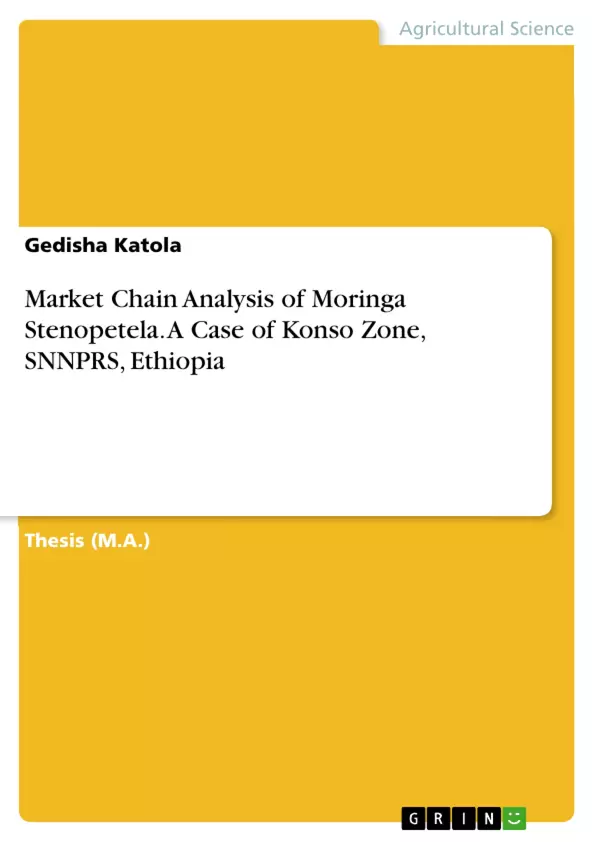
Market Chain Analysis of Moringa Stenopetela. A Case of Konso Zone, SNNPRS, Ethiopia
Magisterarbeit, 2021
127 Seiten, Note: Very Good
Leseprobe
Table of Contents
- Chapter 1: Introduction
- Chapter 2: Literature Review
- Chapter 3: Methodology
- Chapter 4: Results and Discussion
- Chapter 5: Conclusion
Objectives and Key Themes
This thesis analyzes the market chain of Moringa stenopetala in the Konso Zone of the Southern Nations, Nationalities, and Peoples Region (SNNPRS), Ethiopia. The objective is to understand the market dynamics, identify constraints, and suggest improvements to enhance the profitability and sustainability of Moringa production and marketing within the region.
- Market chain analysis of Moringa stenopetala
- Identification of key actors and their roles
- Analysis of market efficiency and profitability
- Assessment of constraints in the Moringa market chain
- Recommendations for improving the Moringa market chain
Chapter Summaries
Chapter 1: Introduction: This chapter introduces the study's background, context, and significance. It highlights the importance of Moringa stenopetala as a nutritious crop and its potential for economic development in the Konso Zone. The chapter establishes the research problem, stating the need for a comprehensive understanding of the Moringa market chain to identify areas for improvement and inform policy interventions. It outlines the research questions and objectives, providing a clear roadmap for the subsequent chapters. The introduction also establishes the scope of the study and defines key terms relevant to the market chain analysis.
Chapter 2: Literature Review: This chapter provides a thorough review of existing literature on Moringa production, market chains, and value chain analysis. It explores various aspects of Moringa cultivation, including its nutritional properties, cultivation practices, and post-harvest handling techniques. The literature review also examines previous studies on market chain efficiency, profitability analysis, and the challenges faced in similar agricultural value chains in developing countries. This chapter lays the groundwork for the study by highlighting the theoretical frameworks and empirical evidence related to the research problem. It identifies gaps in the existing literature that this thesis aims to address.
Chapter 3: Methodology: This chapter details the research methodology employed in the study. It describes the research design, data collection methods, and the analytical techniques used. The chapter explains the sampling procedures, including the selection of respondents and the data collection instruments used. It specifies the statistical methods that will be used for data analysis, such as descriptive statistics and regression analysis. The justification for the chosen methods is provided, emphasizing their suitability for analyzing the market chain and addressing the research questions. This section also clarifies the limitations of the chosen methodology.
Chapter 4: Results and Discussion: This chapter presents the findings of the study, interpreting the collected data and discussing the results in relation to the literature review and research objectives. It provides a detailed analysis of the different stages of the Moringa market chain, from production to consumption, highlighting the key actors involved and their roles. The results regarding market efficiency, profitability, and constraints are presented and discussed. Comparisons are drawn between different segments of the market chain and insights are drawn to illuminate the structure and functionality of the system. This chapter is likely to present statistical evidence and detailed interpretations of findings.
Keywords
Moringa stenopetala, market chain analysis, value chain, Ethiopia, Konso Zone, SNNPRS, market efficiency, profitability, constraints, agricultural economics, development.
Frequently Asked Questions: Moringa stenopetala Market Chain Analysis in the Konso Zone, Ethiopia
What is the overall focus of this thesis?
This thesis analyzes the market chain of Moringa stenopetala in the Konso Zone of the Southern Nations, Nationalities, and Peoples Region (SNNPRS), Ethiopia. The objective is to understand the market dynamics, identify constraints, and suggest improvements to enhance the profitability and sustainability of Moringa production and marketing within the region.
What are the key themes explored in the thesis?
The key themes include market chain analysis of Moringa stenopetala, identification of key actors and their roles, analysis of market efficiency and profitability, assessment of constraints in the Moringa market chain, and recommendations for improving the Moringa market chain.
What chapters are included in the thesis, and what do they cover?
The thesis includes five chapters: Chapter 1 (Introduction) provides background, context, and significance of the study. Chapter 2 (Literature Review) examines existing literature on Moringa production and market chains. Chapter 3 (Methodology) details the research design and data collection methods. Chapter 4 (Results and Discussion) presents and interprets the study's findings. Chapter 5 (Conclusion) summarizes the key findings and offers concluding remarks (not explicitly detailed in the provided preview).
What is the methodology used in this research?
The methodology section details the research design, data collection methods (including sampling procedures and instruments), and analytical techniques (such as descriptive statistics and regression analysis) used in the study. The suitability of these methods for analyzing the market chain is justified, and limitations are also addressed.
What are the key findings presented in the thesis? (Based on the preview)
The provided preview does not present specific findings. Chapter 4 (Results and Discussion), which is not fully detailed, will contain a detailed analysis of the different stages of the Moringa market chain, highlighting key actors, market efficiency, profitability, and constraints.
What are the key words associated with this research?
The keywords are: Moringa stenopetala, market chain analysis, value chain, Ethiopia, Konso Zone, SNNPRS, market efficiency, profitability, constraints, agricultural economics, development.
What is the overall goal of improving the Moringa market chain?
The overall goal is to enhance the profitability and sustainability of Moringa production and marketing in the Konso Zone by identifying and addressing constraints within the market chain.
Details
- Titel
- Market Chain Analysis of Moringa Stenopetela. A Case of Konso Zone, SNNPRS, Ethiopia
- Hochschule
- Arba Minch University (Arba Minch University)
- Veranstaltung
- AgriCultural Economics
- Note
- Very Good
- Autor
- Gedisha Katola (Autor:in)
- Erscheinungsjahr
- 2021
- Seiten
- 127
- Katalognummer
- V1189532
- ISBN (Buch)
- 9783346622662
- Sprache
- Englisch
- Schlagworte
- market chain analysis moringa stenopetela case konso zone snnprs ethiopia
- Produktsicherheit
- GRIN Publishing GmbH
- Preis (Ebook)
- US$ 40,99
- Preis (Book)
- US$ 52,99
- Arbeit zitieren
- Gedisha Katola (Autor:in), 2021, Market Chain Analysis of Moringa Stenopetela. A Case of Konso Zone, SNNPRS, Ethiopia, München, Page::Imprint:: GRINVerlagOHG, https://www.diplomarbeiten24.de/document/1189532
- Autor werden
- Ihre Optionen
- Vertriebskanäle
- Premium Services
- Autorenprofil
- Textarten und Formate
- Services für Verlage, Hochschulen, Unternehmen

- © GRIN Publishing GmbH.
- Alle Inhalte urheberrechtlich geschützt. Kopieren und verbreiten untersagt.
- info@grin.com
- AGB
- Open Publishing
Der GRIN Verlag hat sich seit 1998 auf die Veröffentlichung akademischer eBooks und Bücher spezialisiert. Der GRIN Verlag steht damit als erstes Unternehmen für User Generated Quality Content. Die Verlagsseiten GRIN.com, Hausarbeiten.de und Diplomarbeiten24 bieten für Hochschullehrer, Absolventen und Studenten die ideale Plattform, wissenschaftliche Texte wie Hausarbeiten, Referate, Bachelorarbeiten, Masterarbeiten, Diplomarbeiten, Dissertationen und wissenschaftliche Aufsätze einem breiten Publikum zu präsentieren.
Kostenfreie Veröffentlichung: Hausarbeit, Bachelorarbeit, Diplomarbeit, Dissertation, Masterarbeit, Interpretation oder Referat jetzt veröffentlichen!
- GRIN Verlag GmbH
-
- Nymphenburger Str. 86
- 80636
- Munich, Deutschland
- +49 89-550559-0
- +49 89-550559-10
- info@grin.com
-









